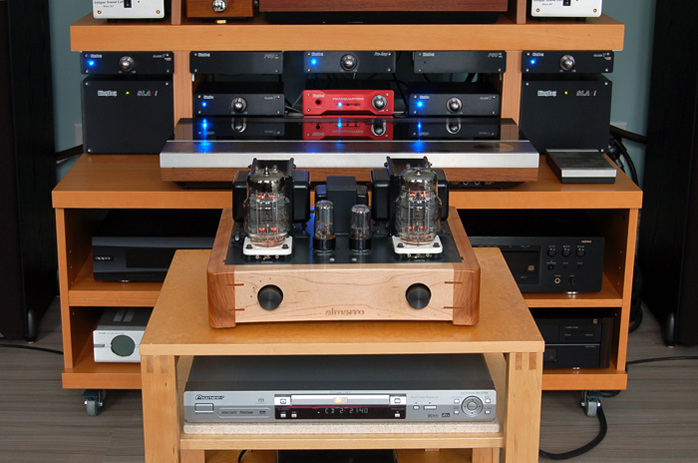This review page is supported in part by the sponsors whose ad banners are displayed below |
 |
 |
|
 |
The JB3F can sound big even with a 6wpc TL66. They won’t back down on a Beethoven symphony, maintaining overall scale of meticulously balanced proportions. But switching to the KingRex T20U built more headroom for orchestral fortés. Soundstaging was better crafted and defined. That prompted me to go to a bigger room partnered with the beefier 18wpc Almarro 318B tube amp. Connected to the 4-ohm tabs, it added a dash of grandiose masculinity that made orchestral tutti more authoritative. But it was the piano which again stole my heart. Spinning inside the Marantz SA8260 SACD player were Tchaikovsky’s most sentimental works. Mikhail Pletnev played Romance Op.5 [Melodiya SUCD 10-00048] with uncontrived lyricism. When the tempestuous Allegro energico resolved to the lovingly tender Andante cantabile theme, my eyes became moist. Chitose Okashiro interpreted the soul-baring Symphony Pathetique [Pro Piano PPR224530] transcribed for piano solo by Walter Niemann with not only virtuoso eloquence but impassioned depth and well-timed emotional eruptions that sent chills down my spine. |
|
|
 |
|
Propelled by the more potent 6C33C tubes of the Almarro amp, the JB3F was intimate as well as intense. This was particularly true with Turkish pianist Ayse Deniz Gokcin’s Pink Floyd Classical Concept which regenerates the rock band’s all-time favourites with her Lisztian finger work. The improvisational album is emotionally touching as well as technically dazzling. It is also sonically rewarding. Some movements are creatively augmented with prepared piano techniques, minimal electronic effects or vocal backing. Truly my best find in 2013. It’s a private label. If you have not heard of this, do yourself a favour by ordering it on Gokcin’s website.
|
|
|
|
|
|
It took me more than a week to put my audio systems back into the renovated basement. A lot of regrouping and reorientation complicated the process but not the outcome. In the end I achieved versatility as well as compatibility. Stereo systems and multi-channel systems coexist in the same room with accessibility to mix and match, contract or expand, by switching a few input selectors or juggling a few interconnects and speaker cables. I had my bearings back and it was time to bring the JB3F in for some comparative listening.
First I put them next to the Mark & Daniel Diamond+. Was I being unkind? Sourcing from the flagship Oppo BDP-105, the Diamond+ had the unfair advantage of its potent air-motion transducers and large-excursion woofers at the command of Audio Zone’s Pre-T1 biamping through Restek-Thorens MMA5 and NuForce Reference 9 V2 SE monoblocks. (At least I didn’t turn on the paired Maximus subwoofers.) The JB3F stayed put with the KingRex PREference and JohnBlue TL66 combo.
|
 |
Sometimes you get fairer results when you do unfair things. I thought I'd set the JB3F up for a harsh test by playing some demanding repertoire. They took up the challenge with grace and adroitness as though being completely insouciant to the gauntlet facing them.
|
 |
My focus was on two outstanding high-definition Blu-ray pure audio recordings by Norwegian label 2L. First was Ståle Kleiberg’s David & Bathsheba [2L-84-SABD], an operatic oratorio rightfully nominated for a Grammy last year featuring the composer’s trademark translucent orchestration and lucid vocal lines. Then came La Voie Triomphale [2L-086-SABD], a collection of large-scale wind orchestral music by French composers from Berlioz (Grande Symphonie Funebre et Triomphale) to Eugene Bozza (Children’s Overture, performed by The Staff Band of the Norwegian Armed Forces under the baton of Ole Kristian Ruud. |
|
|
|
|
|
I'd been spoiling myself with 5.1 DTS high-definition 24bit/192kHz playback of these works through my 12.2 setup with paired centre-channel speakers and paired subwoofers. Would pressing the yellow button on the Oppo remote control switching to 2.0 LPCM produce the proverbial anti climax? Not. Whilst the stereo format was still in 24/192, it sounded harmonically somewhat richer without compromising instrumental localization. The TL66/JB3F combo used that to its fullest advantage by rendering a warm and spacious ambience. It was hard to believe that a pair of 3” drivers could stretch out such a wide sonic canvas with uncongested dimensional details colourfully painted on it.
The Mark & Daniel Diamond+ certainly conveyed more three-dimensional information backed by more intricacy and energy. Understandably the recent development of M&D bookshelf monitors is sliding towards resolution and clarity as opposed to the utterly musical Ruby which debuted the brand.
|
 |
Bass is tight and solid. Layering is well articulated. Naturally it was the JB3F which sounded more musical, delivering not just a warmer midrange but surprisingly more spontaneous unrestrained bass. I would attribute that to the perfect synergy of valve bloom and TQWT enclosure. Vocals were so mellow that the melancholy arias carried a fleshy human touch. Even in the strongest domain of the M&D the JB3F showed no sign of losing out. Transient bursts of percussion sforzandos were swift, clean and spunky. Resonant decays of brass fanfares had effortless luminosity. I am not trying to flatter Jimmy if I say the JB3F is a small single-driver floorstander that makes big miracles. I am as honest as the day is long. And at last the days were getting longer again through the second half of this bitter Canadian winter.
|
 |
Exhibit 1. Four pairs of Loth-X BS-1 in quadruple d'Appolito configuration driven by KingRex Preamp/HQ1/T20U/T20 quad amps. Many years ago I fell in love with this baby widebander with crossover-less tweeter and bought four pairs for a multi-channel application (paired centre channels). Later on I split them up into two different d’d'Appolito bi-amp systems. Now I reunited them in one stereo system, four per channel. The sound was exuberant, rich in detail and impermeable in density.
|
 |
  |
 |